Research on Improved Intelligent Control Processes Based on Three Kinds of Artificial Intelligence
Abstract
1. Introduction
1.1. Related Work
1.2. Contributions
2. PID, E-PID, and F-PID (Existing Methods and Applications)
2.1. Classical PID Model (Existing Methods)
| Algorithm 1 PID (proportion integration differentiation) control method |
|
2.2. E-PID and F-PID Models (Existing Methods)
| Algorithm 2 E-PID (Expert system based PID) and F-PID (Fuzzy calculation based PID) control methods |
|
2.3. Application of E-PID and F-PID (Existing Application)
3. EA-PID and FA-PID Models (Improved Methods)
3.1. FA-PID Model
3.1.1. Improve F-PID to FA-PID
3.1.2. Design of Fuzzy Controller
3.2. EA-PID Model
3.2.1. Improve E-PID to EA-PID:
3.2.2. Design of an Expert Rule Table
3.3. Implementation of EA-PID and FA-PID
| Algorithm 3 EA-PID and FA-PID (which are defined in Definition 3 to 4) control methods |
|
3.4. Comparison of E-PID, F-PID, EA-PID, and FA-PID
4. WNN-PID Model (Improved Method)
4.1. WNN-PID Model
| Algorithm 4 NN-PID(neural network based proportion integration differentiation) control method |
|
4.2. Online Tuning Algorithm of WNN-PID
5. Simulation
5.1. Design and Result Analysis of the Simulations
5.1.1. Simulation of EA-PID and FA-PID
- Anti-interference Configuration 1 for the saturation test.
- 2.
- Anti-interference Configuration 2 for the unsaturation experiment.
- The control speed of EA-PID is the best: The rising curve (especially when AC is at 0 to 500) in Figure 7 and Figure 8 shows that E-PID and EA-PID are faster than F-PID and FA-PID. EA-PID has the fastest speed to reach a steady state (settling time of EA-PID is the smallest value). The speed of FA-PID is faster than F-PID (shorter rise time and steady time). Only EA-PID has overshot.
- EA-PID has the best ability of anti-interference, FA-PID has the second-best ability of anti-interference, E-PID is saturated under the influence of continuous interference, and F-PID is the worst performer (unstable, does not converge) when AC is at 2000 to 10,000 in Figure 7.
- The anti-interference ability and recovery speed of EA-PID are the best. The recovery curve (when AC is at 2010 to 2300) in Figure 8 shows that the recovery time of EA-PID is the shortest. The maximum values of system output in Simulation 1 (Figure 7) prove that the control system is unsaturation in Simulation 2 (Figure 8) because the amplitude of system output in Simulation 1 (with longer time of interference) is larger than in Simulation 2.
5.1.2. Simulation of BPNN-PID, RBFNN-PID, and WNN-PID
5.2. Comparison and Analysis of all Simulations
5.2.1. Analysis of Dynamic and Steady-State
- Most features of EA-PID are the best because all the EA-PID result data (line 2) in Table 9 have the smallest values. Therefore, the improvement of EA-PID is successful.
- FA-PID is better than F-PID because all the FA-PID result data (line 4) in Table 9 are smaller values than F-PID (line 3). Therefore, an improvement from F-PID to FA-PID is successful.
- Most speed features of WNN-PID (line 7) are better than BPNN-PID (line 5), but the steady-state error feature of WNN-PID is not. RBFNN-PID (line 6) did not participate in the comparison because it is unstable.
5.2.2. Analysis of Anti-Interference
- Start time of interference (IST) is set after the adjustment time (when the system output reaches 90% of system input). For most AI-CC methods, IST is set to 2000. In RBFNN-S-PID method, IST is set to 3000 because of RBFNN-S-PID >2000. Duration time of interference (IDT) is set to 100 ACs.
- The maximum simulation time is set to be long enough to ensure that the recovery process from interference can be clearly observed.
- All the other simulation parameters are set to be the same value as in the previous sections.
6. Theoretical Analysis of Stability
6.1. Basis of Theoretical Analysis
6.2. Theoretical Analysis of Stability
- In order to ensure the real-time stability of the system, only the stable parameters (which are tuned by AI-CC methods and judged to make the system stable) will be accepted;
- All the unstable parameters will be rejected. In this case, the previous stable parameters are retained and used continuously.
6.3. Verification of Stability
- The unstable RBFNN-PID method is selected as a research case.
- 2.
- AI-CC-S method is proposed
sys=tf(200,[1,30,1],’inputdelay’,1); sys_pid=tf([kd2bc,kp2bc,ki2bc],[1,0]); sys_open=sys*sys_pid; [bode_mag,bode_phase,bode_w]=bode(sys_open); [bode_gm,bode_pm,bode_wcg,bode_wcp]=margin(bode_mag,bode_phase,bode_w); |
- 3.
- RBFNN-S-PID is proposed
7. Conclusions
- All AI-CC methods completed the control parameter online-tuning process (100% stable and convergence) except RBFNN-PID. The unstable problem of RBFNN-PID can be solved by the stability guarantee algorithm proposed in this study.
- The control speed of EA-PID is the fastest (average = 94 and average = 293 are the smallest values). FA-PID (average = 102, average = 469) is better than F-PID (average = 158, average = 519). WNN-PID (average = 155, min Tr = 106, min = 468) is better than BPNN-PID (average = 192, min = 146, min = 602).
- Stability of EA-PID is the best (average steady-state error = 0.000977 is the smallest value). FA-PID (average steady-state error = 0.004536) is better than F-PID (average steady-state error = 0.006044).
- The robust (anti-interference) feature of most AI-CC methods is acceptable except RBFNN-PID: the problem of RBFNN-PID can be solved by adding the stability guarantee algorithm; other AI-CC systems can recover steady-state after interference. EA-PID has the fastest speed of recovery (average recovery time is 75, which is the smallest value).
- The stability guarantee algorithm is effective for all AI-CC methods. Most AI-CC methods are stable (100% convergence) except RBFNN-PID, but RBFNN-S-PID (RBFNN-PID with stability guarantee algorithm) is stable. Therefore, the AI-CC method with the stability guarantee algorithm proposed in this study can be widely applied.
- Parameter configuration work for engineers: E-PID and F-PID methods require precise configuration for parameters. E-PID determines parameters by querying the rule table. EA-PID and FA-PID methods decide parameters by querying an improved rule table and making calculations. For the above XNN-PID, engineers need to set the initial control parameters by experience or use the default values and design some parameters, like the number of hidden layers, the number of neurons in each layer, and the choice of the performance function. Then, the system will optimize and tune parameters in the online running process.
Author Contributions
Funding
Conflicts of Interest
References
- Åström, K.J.; Hägglund, T. The future of PID control. Control Eng. Pract. 2001, 9, 1163–1175. [Google Scholar] [CrossRef]
- Pritesh, S.; Agashe, S. Review of fractional PID controller. Mechatronics 2016, 38, 29–41. [Google Scholar]
- Hang, C.C.; Astrom, K.J.; Wang, Q.G. Relay feedback auto-tuning of process controllers—A tutorial review. J. Process. Control 2002, 12, 143–162. [Google Scholar] [CrossRef]
- Berner, J.; Hägglund, T.; Åström, K.J. Asymmetric relay autotuning—Practical features for industrial use. Control Eng. Pract. 2016, 54, 231–245. [Google Scholar] [CrossRef]
- Soltesz, K.; Mercader, P.; Banos, A. An automatic tuner with short experiment and probabilistic plant parameterization. Int. J. Robust Nonlinear Control 2017, 27, 1857–1873. [Google Scholar] [CrossRef]
- Carlucho, I.; de Paula, M.; Villar, S.A.; Acosta, G.G. Incremental q-learning strategy for adaptive pid control of mobile robots. Expert Syst. Appl. 2017, 80, 183–199. [Google Scholar] [CrossRef]
- Cortes, P.; Kazmierkowski, M.P.; Kennel, R.M.; Quevedo, D.E.; Rodriguez, J. Predictive control in power electronics and drives. IEEE Trans. Ind. Electron. 2008, 55, 4312–4324. [Google Scholar] [CrossRef]
- Howe, R.; Faber, H.; Casey, B. Occupational health and safety-a key engineering design consideration for botanical resources australia pty ltd. In I International Symposium on Pyrethrum, The Natural Insecticide: Scientific and Industrial Developments in the Renewal of a 1073; ISHS: Leuven, Belgium, 2011; pp. 79–84. [Google Scholar]
- Mnih, V.; Kavukcuoglu, K.; Silver, D.; Rusu, A.A.; Veness, J.; Bellemare, M.G.; Petersen, S. Human-level control through deep reinforcement learning. Nature 2015, 518, 529–533. [Google Scholar] [CrossRef] [PubMed]
- Vassilyev, S.N.; Kelina, A.Y.; Kudinov, Y.I.; Pashchenko, F.F. Intelligent control systems. Procedia Comput. Sci. 2017, 103, 623–628. [Google Scholar] [CrossRef]
- Delean, B. Computerized Driverless Vehicles and Traffic Control System. U.S. Patent No. 8,090,489, 3 January 2012. [Google Scholar]
- Schmidhuber, J. Deep learning in neural networks: An overview. Neural Netw. 2015, 61, 85–117. [Google Scholar] [CrossRef] [PubMed]
- Goodfellow, I.; Bengio, Y.; Courville, A. Deep Learning; MIT Press: Cambridge, MA, USA, 2016. [Google Scholar]
- Sutton, R.S.; Barto, A.G. Reinforcement Learning: An Introduction; MIT Press: Cambridge, MA, USA, 2018. [Google Scholar]
- Tzafestas, S.; Papanikolopoulos, N.P. Incremental fuzzy expert PID control. IEEE Trans. Ind. Electron. 1990, 37, 365–371. [Google Scholar] [CrossRef]
- Mayne, D.Q. Model predictive control: Recent developments and future promise. Automatica 2014, 50, 2967–2986. [Google Scholar] [CrossRef]
- Borrelli, F.; Bemporad, A.; Morari, M. Predictive Control for Linear and Hybrid Systems; Cambridge University Press: Cambridge, UK, 2017. [Google Scholar]
- Krogh, A.; Vedelsby, J. Neural network ensembles, cross validation, and active learning. In Advances in Neural Information Processing Systems; MIT Press: Cambridge, MA, USA, 1995; pp. 231–238. [Google Scholar]
- Bellman, R.E. Adaptive Control Processes: A Guided Tour; Princeton University Press: Princeton, NJ, USA, 2015; Volume 2045. [Google Scholar]
- Zhao, W.B.B.; Zhenfan, L.T. Neural network based online self-learning adaptive PID control. In Proceedings of the 3rd World Congress on Intelligent Control and Automation, Hefei, China, 26 June–2 July 2000; IEEE: Piscataway, NJ, USA, 2000; Volume 2, pp. 908–910. [Google Scholar]
- Sharifian, M.B.B.; Mirlo, A.; Tavoosi, J.; Sabahi, M. Self-adaptive RBF neural network PID controller in linear elevator. In Proceedings of the 2011 International Conference on Electrical Machines and Systems, Beijing, China, 20–23 August 2011; IEEE: Piscataway, NJ, USA, 2011; pp. 1–4. [Google Scholar]
- Chen, H.Y.; Liang, J.W. Piezoelectric-actuated drop-on-demand droplet generator control using adaptive wavelet neural network controller. J. Process Control 2014, 24, 578–585. [Google Scholar] [CrossRef]
- Kang, F.; Liang, Y.B. Research on modeling and simulation of expert pid controlled servo system based on matlab/s-function. In Applied Mechanics and Materials; Trans Tech Publ: Stafa-Zurich, Switzerland, 2013; Volume 347, pp. 604–609. [Google Scholar]
- Ji, Y.L.; Sun, Y.L.; Wen, F. Robot Arm Motion Control Based on Trapezoidal Fuzzy PID Algorithm. Basic Clin. Pharmacol. Toxicol. 2020, 126, 193–194. [Google Scholar]
- González-Briones, A.; Prieto, J.; de la Prieta, F.; Herrera-Viedma, E.; Corchado, J.M. Energy optimization using a case-based reasoning strategy. Sensors 2018, 18, 865. [Google Scholar] [CrossRef] [PubMed]
- González-Briones, A.; Chamoso, P.; Yoe, H.; Corchado, J.M. GreenVMAS: Virtual organization based platform for heating greenhouses using waste energy from power plants. Sensors 2018, 18, 861. [Google Scholar] [CrossRef] [PubMed]
- Sergio, A.; Carvalho, S.; Marco, R.E.G.O. On the Use of Compact Approaches in Evolution Strategies. ADCAIJ Adv. Distrib. Comput. Artif. Intell. J. 2014, 3, 13–23. [Google Scholar]

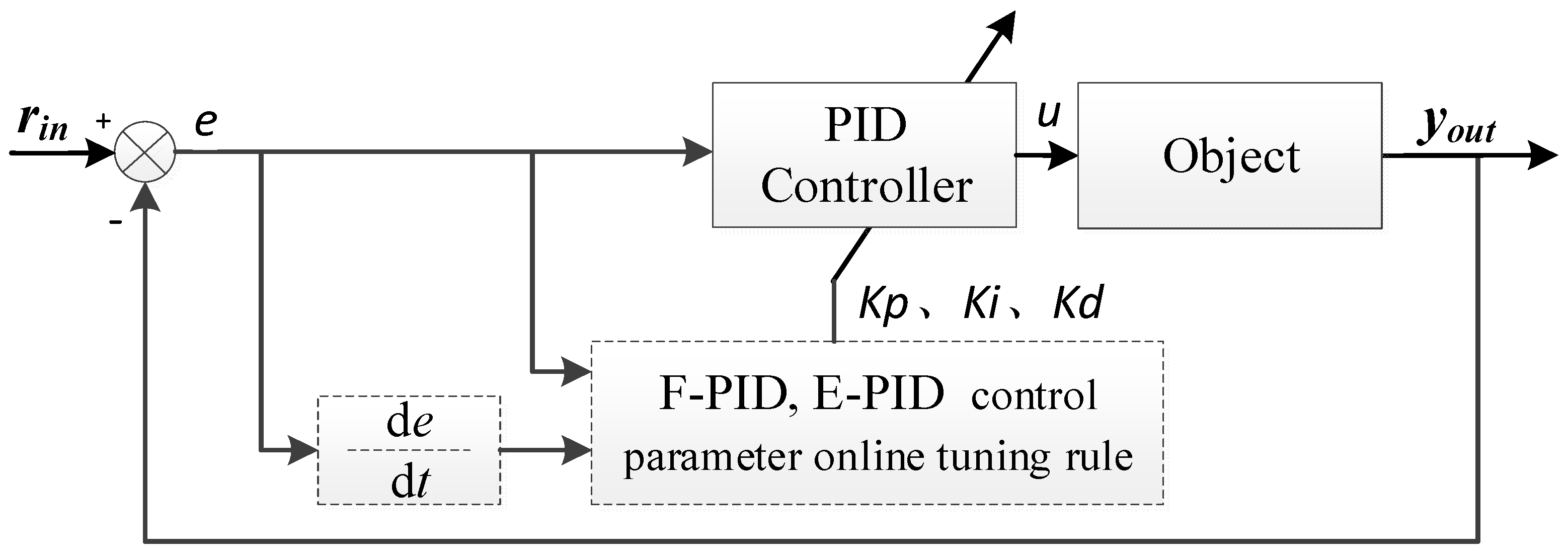
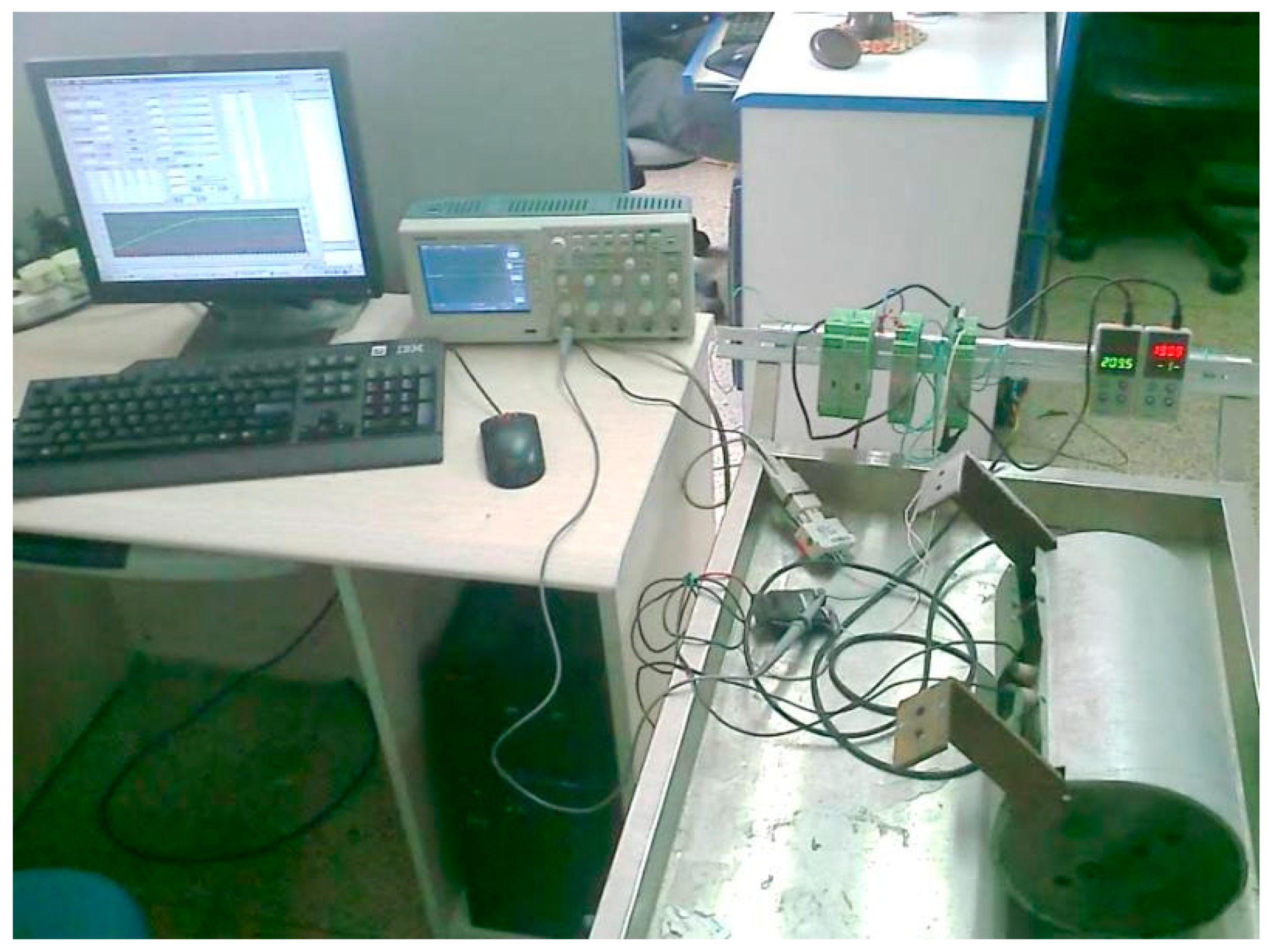
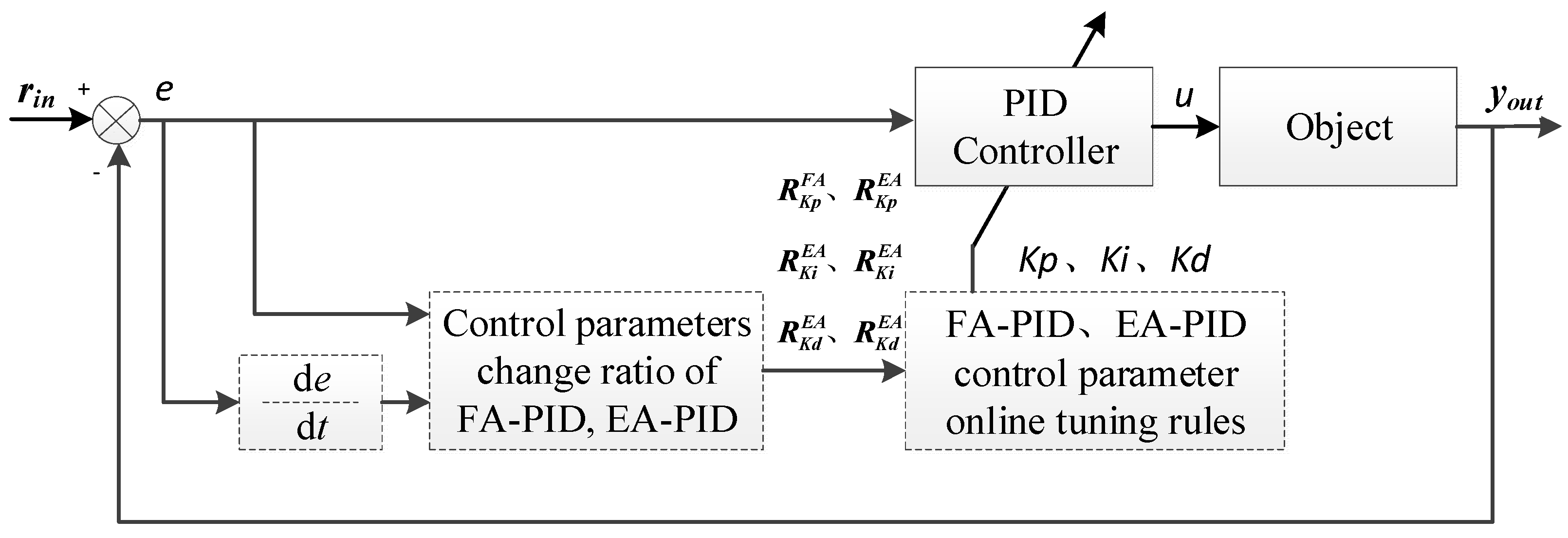


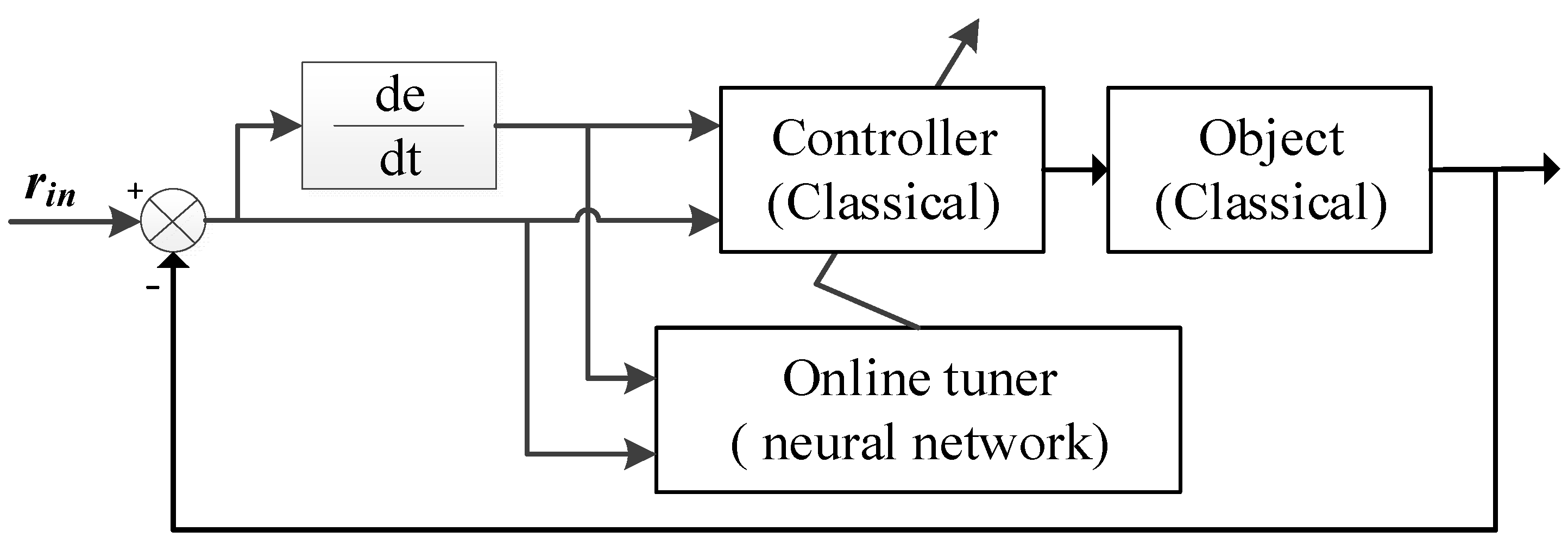

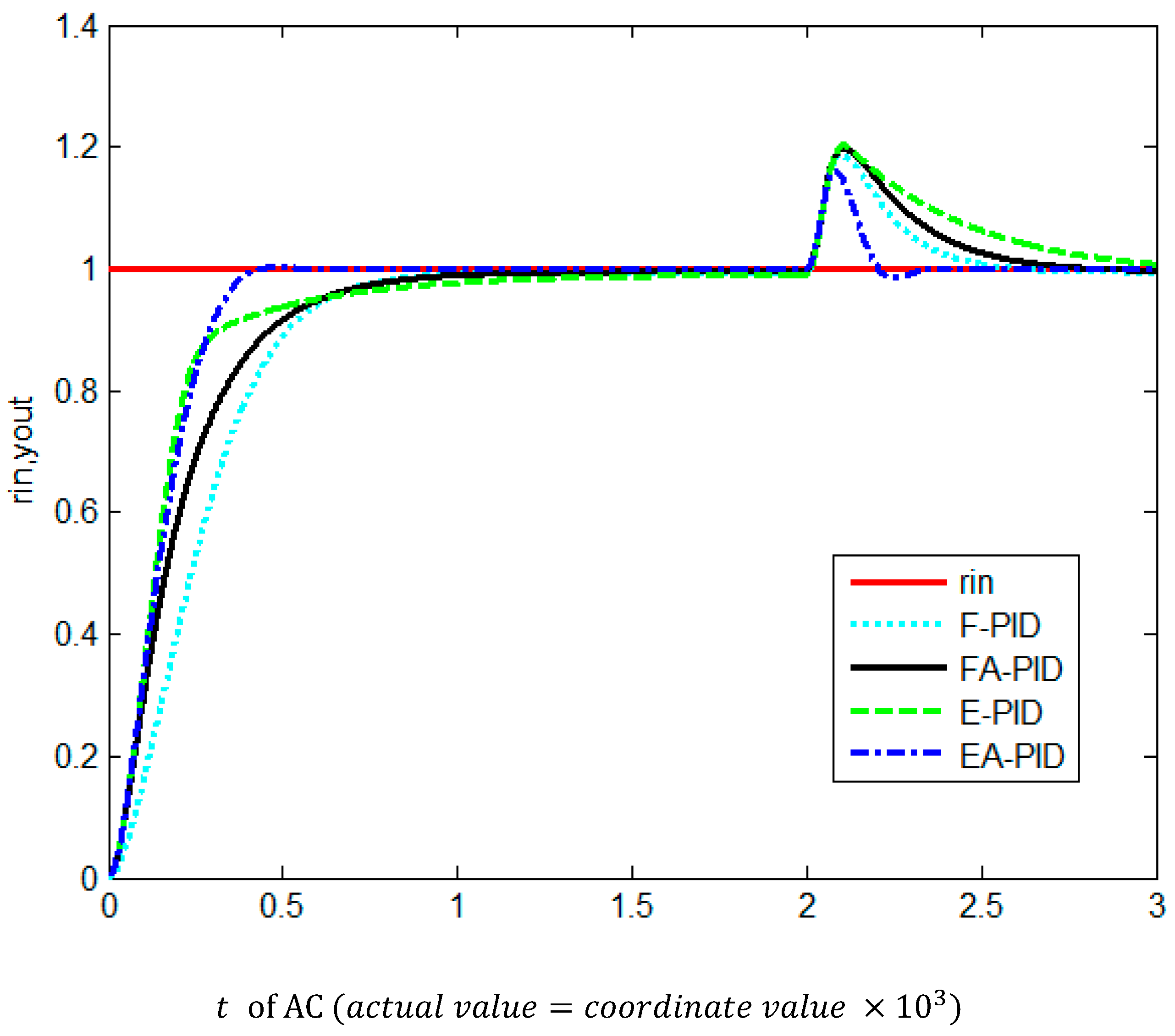
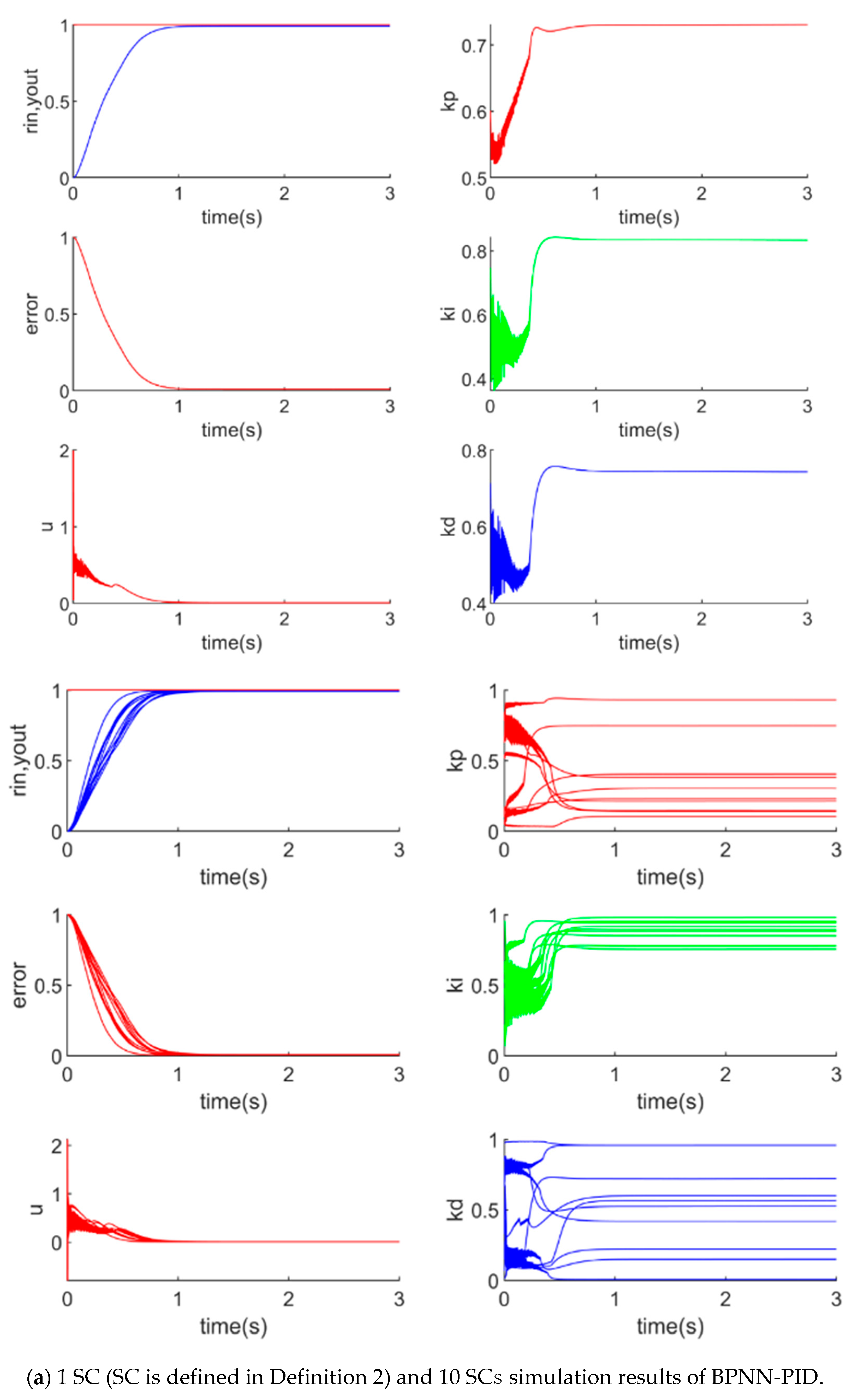
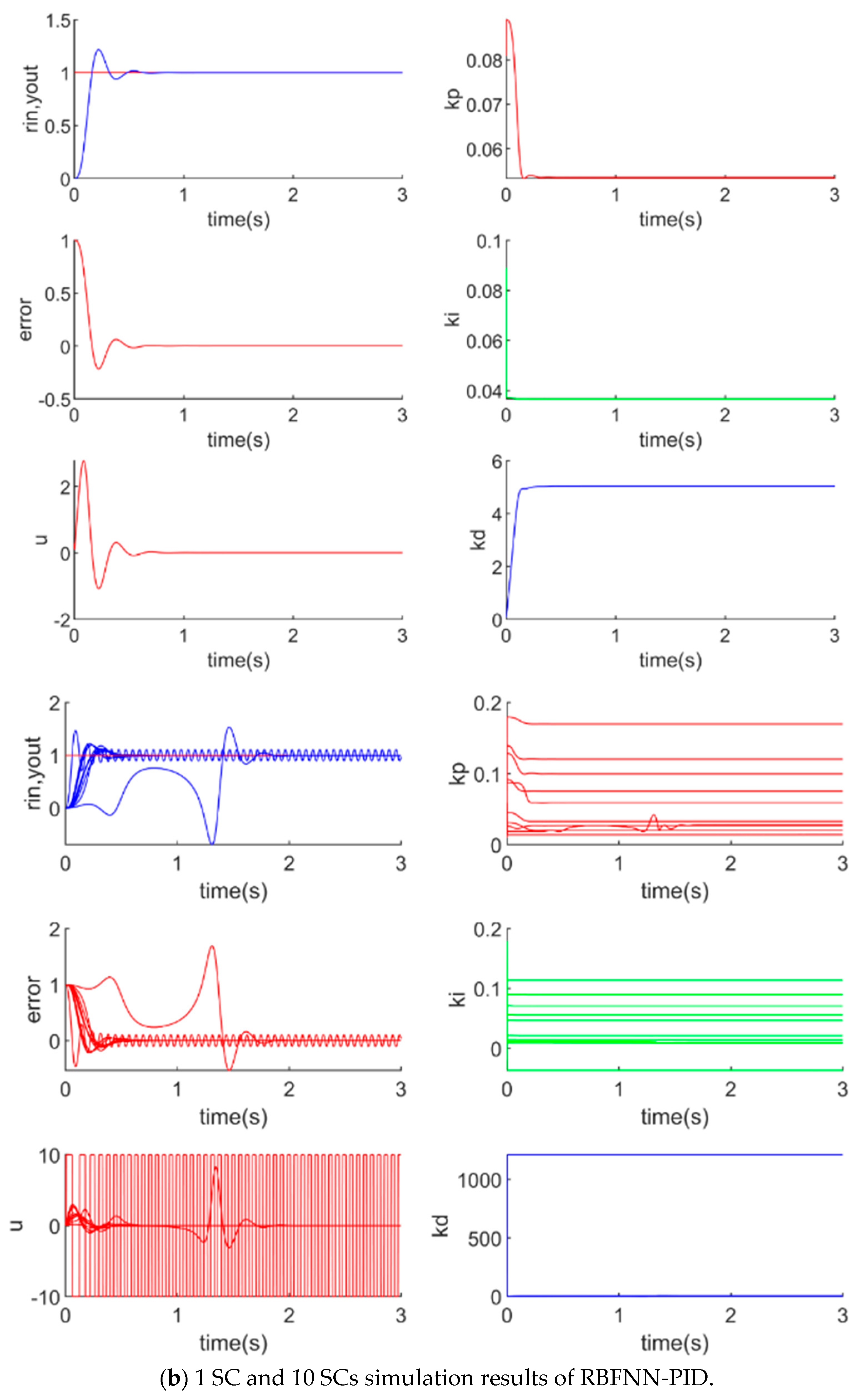
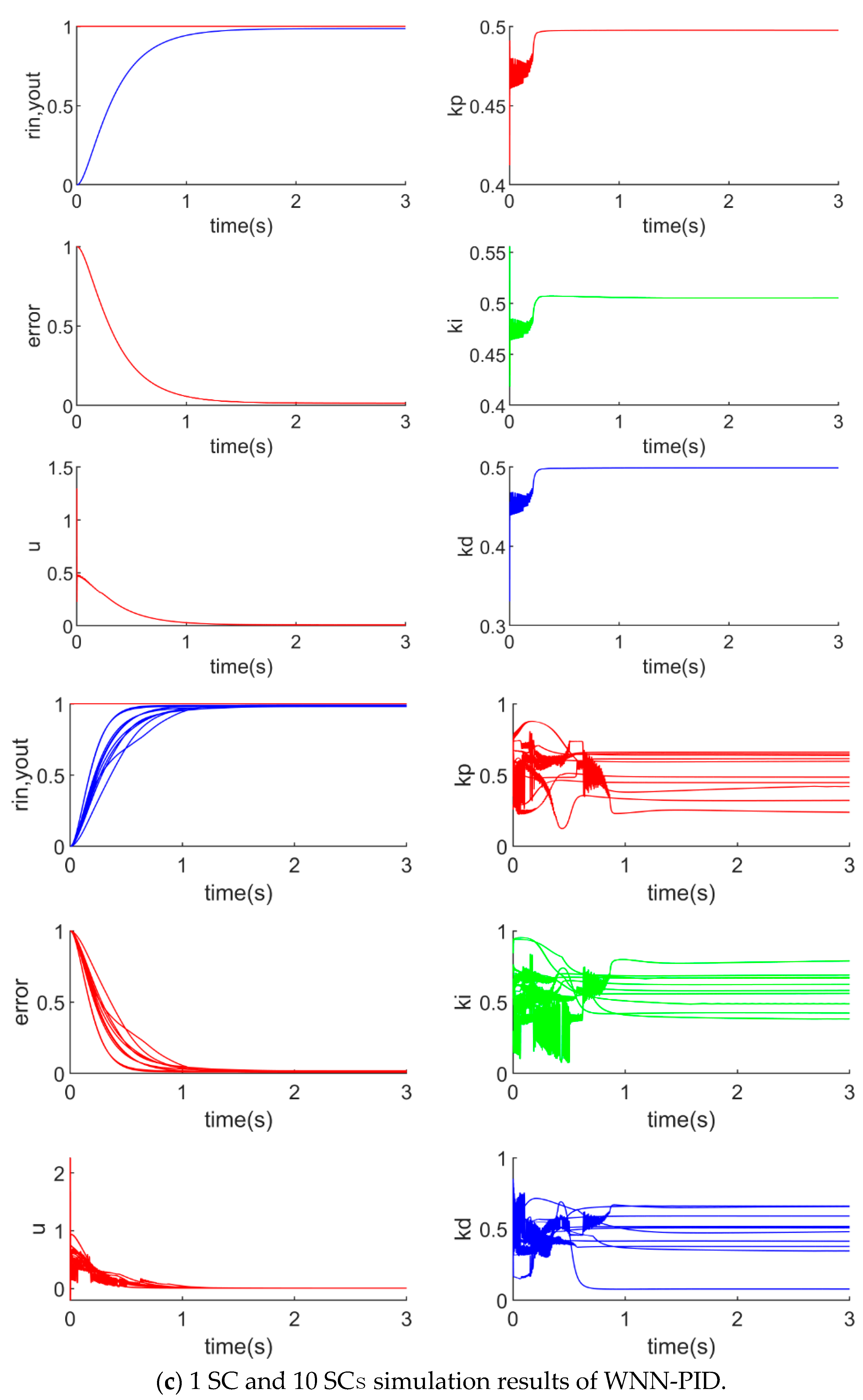

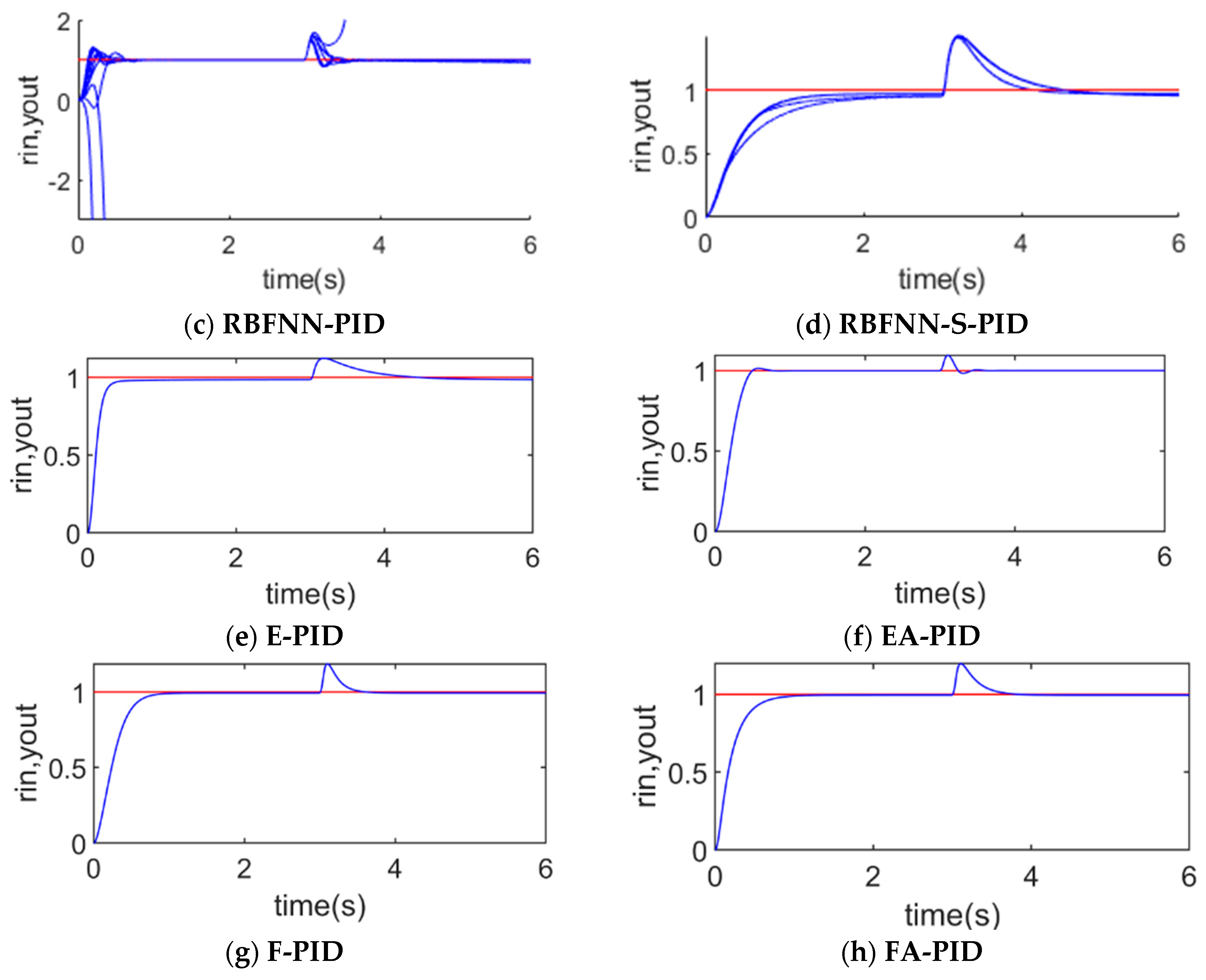
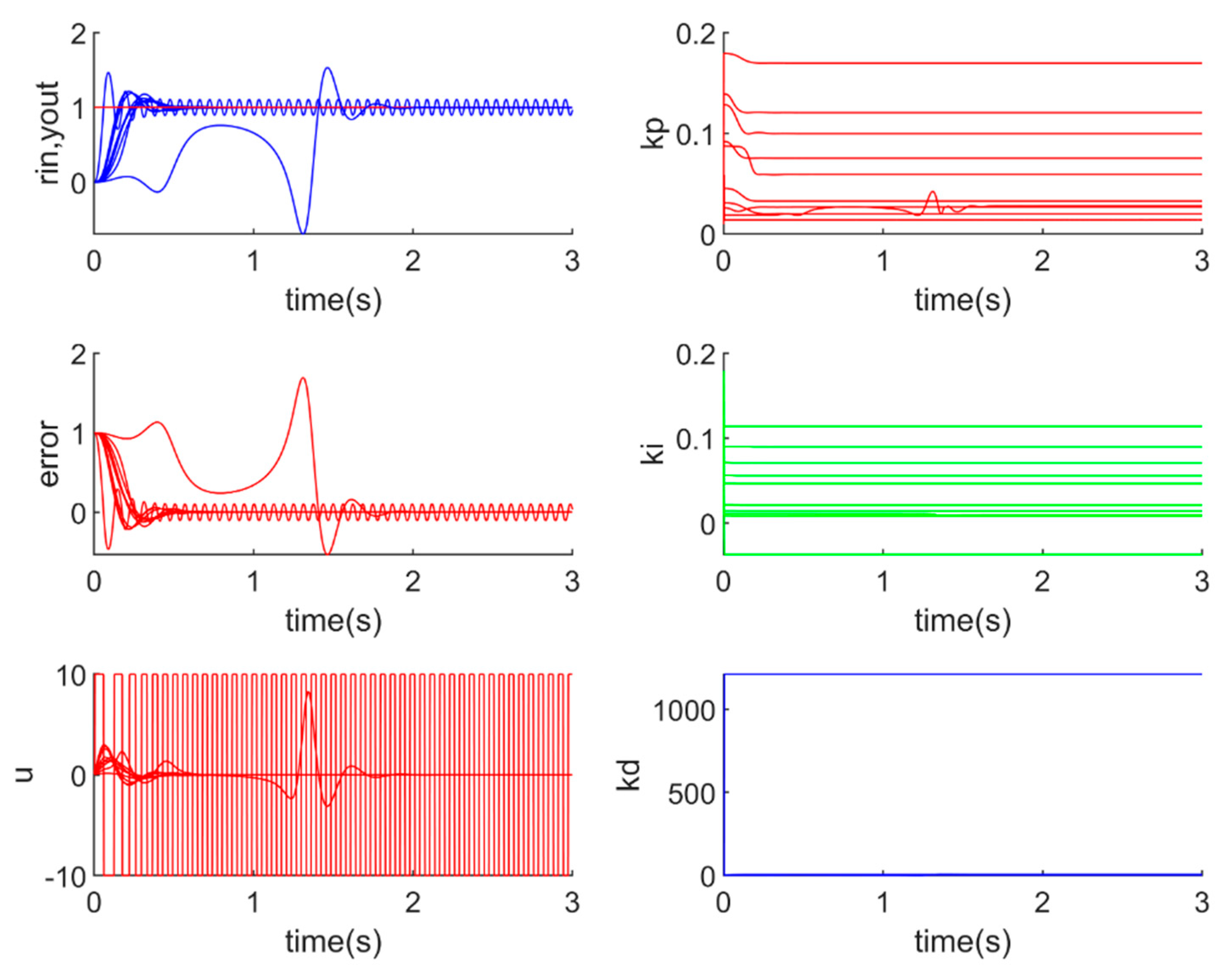
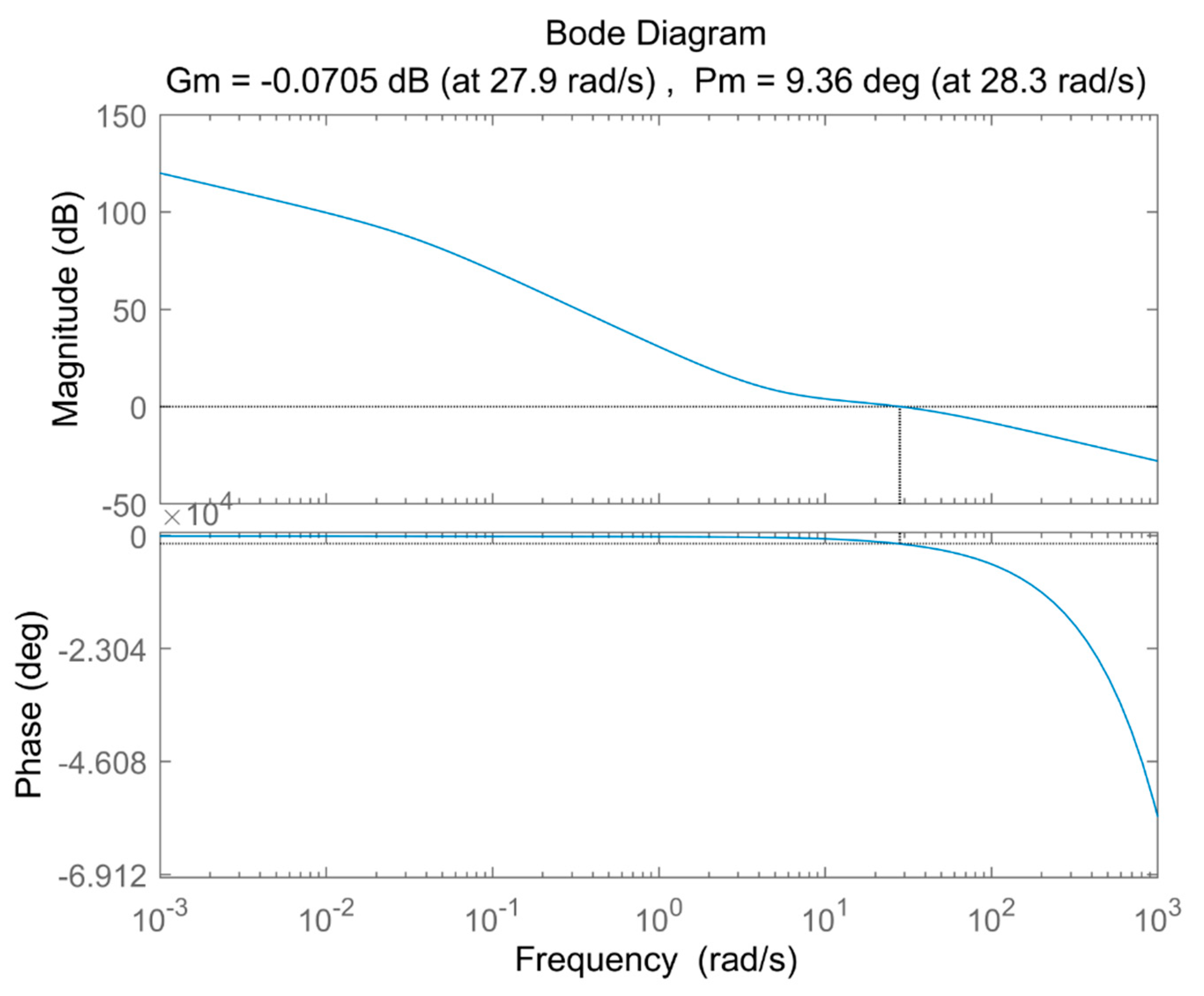
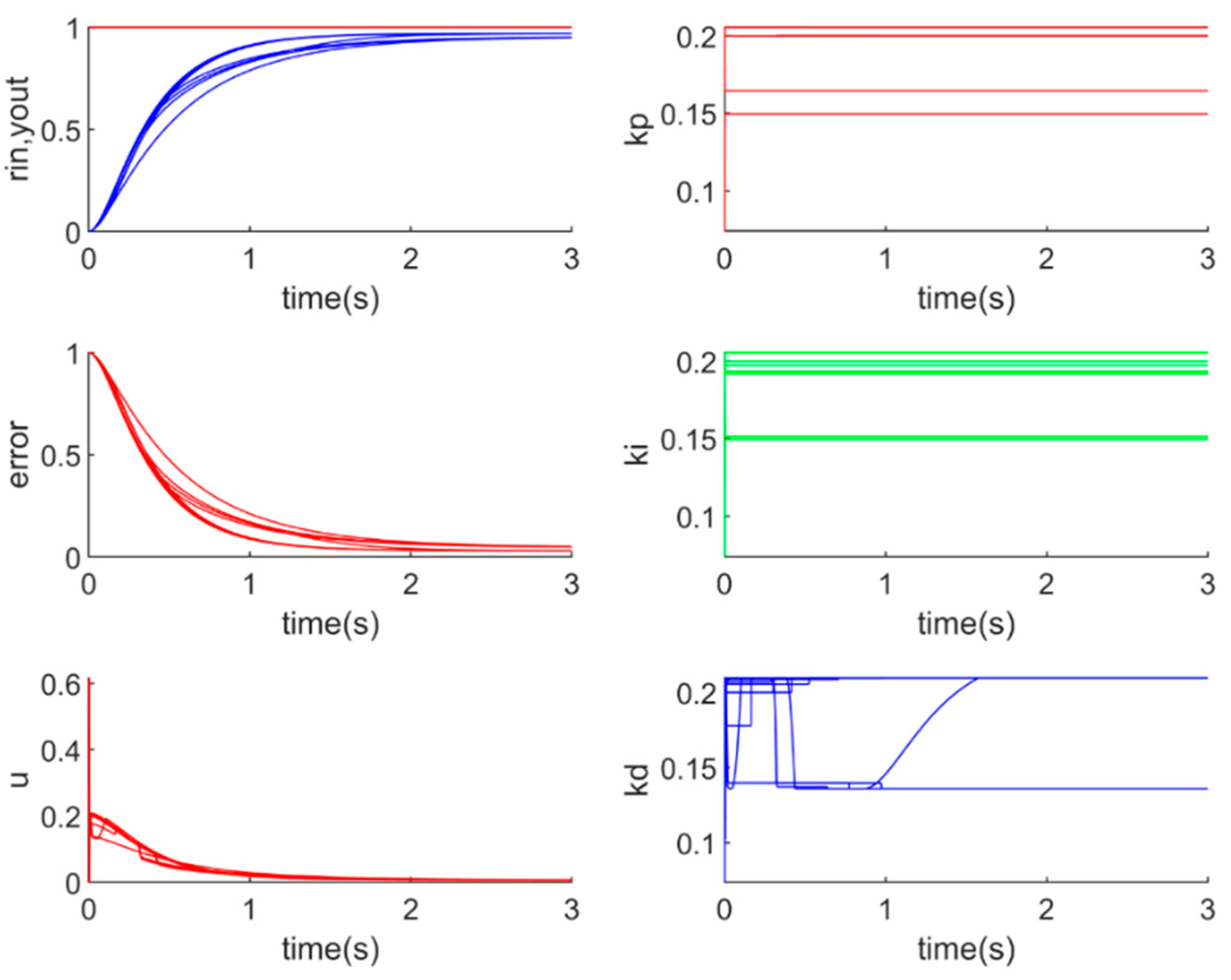
| 1 | 0.998 | 0.998 | |
| 1.002 | 1 | 1 | |
| 1.004 | 1.002 | 1 |
| 1 | 0.998 | 0.998 | |
| 1.002 | 1 | 1 | |
| 1.004 | 1.002 | 1 |
| 1.002 | 1.002 | 1.002 | |
| 1 | 1 | 1 | |
| 0.998 | 0.998 | 0.998 |
| E-PID | EA-PID | F-PID | FA-PID | |
|---|---|---|---|---|
| Online-tuning principles | new PID parameters are obtained directly from the rule table | new PID parameters at time are calculated by old PID parameters at time with change ratio from the rule table | new PID parameters are obtained directly from fuzzy computing | new PID parameters at time are calculated by old PID parameters at time with a change ratio from fuzzy computing |
| Online tuning calculations | expert rule table | expert rule table | fuzzy computing | fuzzy computing |
| Output calculations | PID parameters: | Change ratio for PID parameters: | PID parameters: | Change ratio for PID parameters: |
| Tuning results | . |
| Comparison→ Method↓ | Rise Time Tr | Settling Time Ts | Overshoot | Steady-State Error | Deviation from Steady-State | Recovery Time |
|---|---|---|---|---|---|---|
| E-PID | fastest (180) | fast (600) | No | largest (1.0%) | worst (20.3%) | slowest (1000) |
| EA-PID | fast (200) | fastest (330) | Yes (0.2%) | smallest (0.1%) | best (16.1%) | fastest (275) |
| F-PID | slowest (340) | slowest (630) | No | large (0.6%) | good (18.7%) | fast (515) |
| FA-PID | slow (260) | slow (610) | No | small (0.5%) | bad (19.7%) | slow (700) |
| Comparison→ SC Number↓ | BPNN -PID Tr | BPNN -PID Ts | BPNN -PID St-Err | RBFNN -PID Tr | RBFNN -PID Ts | RBFNN -PID St-Err | WNN -PID Tr | WNN -PID Ts | WNN -PID St-Err |
|---|---|---|---|---|---|---|---|---|---|
| 1 | 202 | 1257 | 0.009955 | 107 | 300 | 0.004537 | 173 | 890 | 0.012301 |
| 2 | 228 | 979 | 0.007576 | 102 | 265 | 0.004208 | 173 | 959 | 0.013048 |
| 3 | 262 | 972 | 0.007228 | 132 | 272 | 0.002586 | 257 | 1116 | 0.01006 |
| ⦙ | ⦙ | ⦙ | ⦙ | ||||||
| 30 | 260 | 963 | 0.007081 | 231 | 1212 | 0.018847 | 259 | 1228 | 0.080704 |
| minimum | 132 | 512 | 0.006629 | 96 (unstable) | 221 (unstable) | 0.000567 | 110 (improved) | 495 (improved) | 0.006963 |
| mean | 230 | 926 | 0.007537 | 152 (unstable) | 372 (unstable) | 0.026832 | 166 (improved) | 849 (improved) | 0.018646 |
| maximum | 502 | 1969 | 0.013868 | 846 (unstable) | 1212 (unstable) | 0.694877 | 259 (improved) | 1370 (improved) | 0.080704 (improved) |
| Comparison→ SC Number↓ | BPNN -PID | BPNN -PID St-Err | RBFNN -PID | RBFNN -PID | RBFNN-PID St-Err | WNN -PID | WNN -PID | WNN -PID St-Err |
|---|---|---|---|---|---|---|---|---|
| Group 1 | 217.6 | 0.007525 | 148.7 | 422.3 | 0.050000 | 177.6 | 877.3 | 0.020540 |
| Group 2 | 228.9 | 0.007318 | 108.2 | 302.5 | 0.003189 | 173.1 | 893.3 | 0.016462 |
| Group 3 | 213.3 | 0.007746 | 160.1 | 407.7 | 0.050725 | 157.3 | 789.1 | 0.01 |
| Comparative Item→ Method↓ | Mean of Rise Time | Mean of Settling Time | Mean of Steady-State Error | Minimum of Rise Time | Minimum of Settling Time | Minimum of Steady-State Error |
|---|---|---|---|---|---|---|
| E-PID | 94 | 326 | 0.008839 | 94 | 326 | 0.008839 |
| (Fastest) | (Fastest) | |||||
| EA-PID | 94 | 293 | 0.000977 | 94 | 293 | 0.000977 |
| (Fastest) | (Fastest) | (smallest) | (Fastest) | (Fastest) | (smallest) | |
| F-PID | 158 | 519 | 0.006044 | 158 | 519 | 0.006044 |
| FA-PID | 102 | 469 | 0.004536 | 102 | 469 | 0.004536 |
| (improved) | (improved) | (improved) | (improved) | (improved) | (improved) | |
| BPNN-PID | 192 | 804 | 0.008034 | 146 | 602 | 0.006708 |
| RBFNN-PID | 134 | 387 | 0.00416 | 97 | 222 | 0.001666 |
| (Unstable) | (Unstable) | (Unstable) | (Unstable) | (Unstable) | (Unstable) | |
| WNN-PID | 155 | 826 | 0.016076 | 106 | 468 | 0.00741 |
| (improved) | (improved) | (improved) |
| Method→ Comparative Item↓ | E-PID | EA-PID | F-PID | FA-PID | BPNN-PID | RBFNN-PID | WNN-PID |
|---|---|---|---|---|---|---|---|
| Stable (Convergence) | All stable | All stable | All stable | All stable | All stable | 90% stable (100% stable in RBFNN-S-PID) | All stable |
| Control Speed (means of and ) [minimum of and ] | (94,326) [same as ↑] | Fastest (94,293) [same as ↑] | (158,519) [same as ↑] | Better than F-PID (102,469) [same as ↑] | (192,804) [146,602] | Not be compared because unstable | Some are better than BPNN-PID (155,826) [106,468] |
| Steady-state error (means) | (0.008839) | Best (0.000977) | (0.006044) | Better than F-PID (0.004536) | (0.008034) | Not be compared because unstable | (0.007410) |
| Anti-interference (means of recover time) | (781) | Best (75) | (301) | (468) | (1135) | Not be compared because unstable | (2037) |
| Stability analysis (Convergence) | Stable: 100% convergence | Stable: 100% convergence | Stable: 100% convergence | Stable: 100% convergence | Stable: 100% convergence | Unstable, RBFNN-S-PID is stable | Stable: 100% convergence |
| Parameters configuration work for engineers | Fill in expert rule table for | Expert rule table for and Any stable | Fuzzy and defuzzy rules for | Fuzzy rules for and Any stable | design and train neural network | design and train neural network | design and train neural network |
© 2020 by the authors. Licensee MDPI, Basel, Switzerland. This article is an open access article distributed under the terms and conditions of the Creative Commons Attribution (CC BY) license (http://creativecommons.org/licenses/by/4.0/).
Share and Cite
Liu, J.; Li, T.; Chen, J.; Zuo, F. Research on Improved Intelligent Control Processes Based on Three Kinds of Artificial Intelligence. Processes 2020, 8, 1042. https://doi.org/10.3390/pr8091042
Liu J, Li T, Chen J, Zuo F. Research on Improved Intelligent Control Processes Based on Three Kinds of Artificial Intelligence. Processes. 2020; 8(9):1042. https://doi.org/10.3390/pr8091042
Chicago/Turabian StyleLiu, Jingwei, Tianyue Li, Jiaming Chen, and Fangling Zuo. 2020. "Research on Improved Intelligent Control Processes Based on Three Kinds of Artificial Intelligence" Processes 8, no. 9: 1042. https://doi.org/10.3390/pr8091042
APA StyleLiu, J., Li, T., Chen, J., & Zuo, F. (2020). Research on Improved Intelligent Control Processes Based on Three Kinds of Artificial Intelligence. Processes, 8(9), 1042. https://doi.org/10.3390/pr8091042





